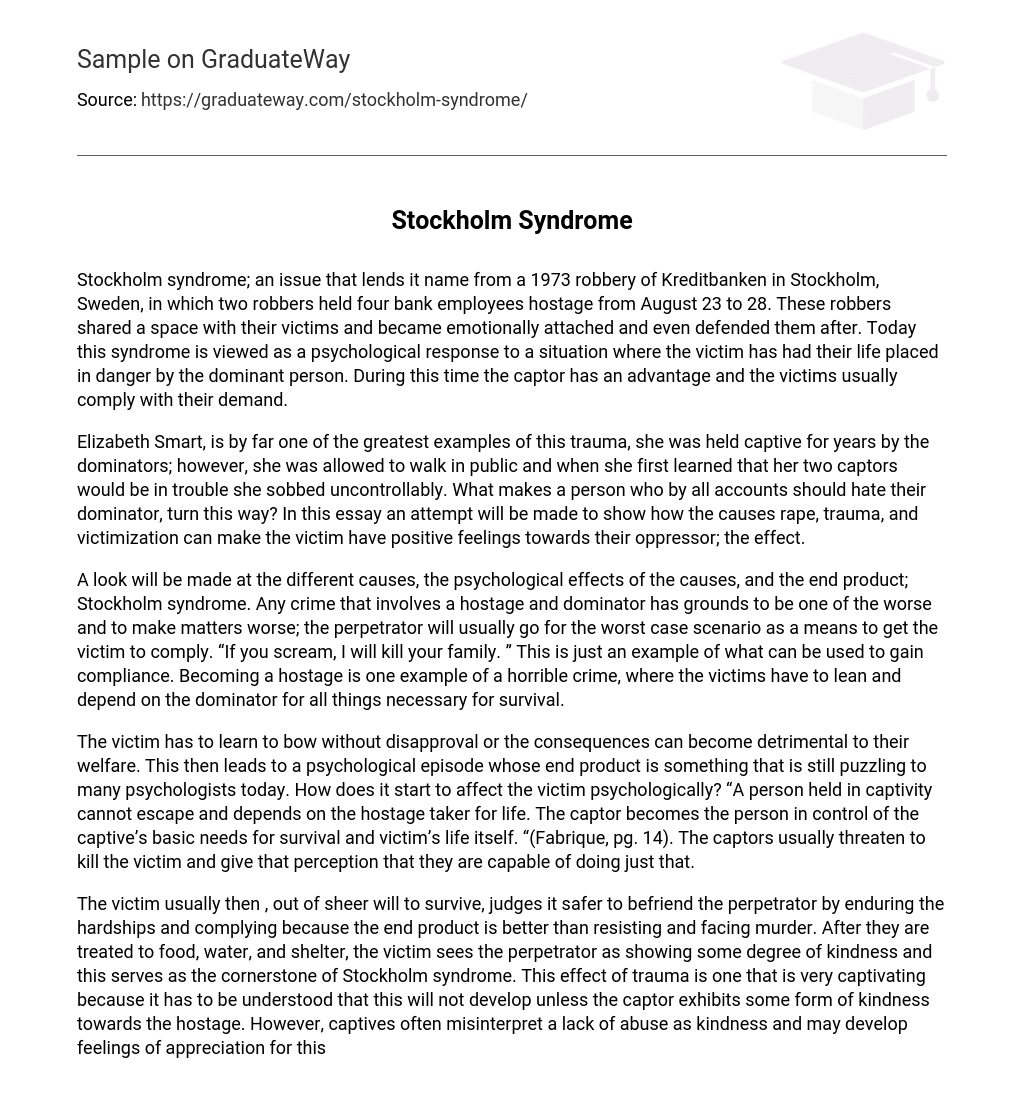Stockholm syndrome derives its name from a 1973 incident at Kreditbanken in Stockholm, Sweden. In this event, four bank employees were held hostage by two robbers from August 23 to 28. Surprisingly, the captors developed an emotional bond with their victims and even protected them. Presently, this syndrome is recognized as a psychological reaction to life-threatening situations where the dominant individual places the victim at risk. In such circumstances, the hostage often complies with the captor’s demands due to their disadvantaged position.
Elizabeth Smart, a prime example of trauma, experienced years in captivity under her dominators. Despite this, she was occasionally granted freedom to walk in public. When she discovered that her captors would face consequences, she was overcome with uncontrollable sobbing. How is it possible for someone who should despise their oppressor to feel this way? This essay aims to demonstrate the ways in which rape, trauma, and victimization can lead victims to develop positive sentiments towards their oppressors, and the impact it has.
The text examines the various causes, the psychological effects of these causes, and the resulting phenomenon known as Stockholm syndrome. Any crime involving a hostage and a dominator has the potential to be extremely severe. To make matters worse, perpetrators often resort to the most extreme measures in order to force compliance from their victims. For instance, they might threaten to harm the victim’s family if they scream. Becoming a hostage is a horrific crime that forces victims to rely entirely on their captors for their survival.
The victim must learn to submit without disapproval or else the consequences can be harmful to their well-being. This ultimately leads to a psychological phenomenon that continues to puzzle psychologists today. How does it begin to impact the victim’s mental state? “When someone is held captive, they have no means of escape and rely on the captor for their very existence. The captor gains control over the captive’s basic necessities for survival and their life itself” (Fabrique, pg. 14). Typically, captors employ threats of violence and create a perception that they are capable of carrying out such acts.
The victim typically feels it is safer to endure the hardships and comply with the perpetrator, as the alternative of resisting and facing murder seems more dangerous. By providing the victim with food, water, and shelter, the perpetrator is seen as displaying a certain level of kindness, which forms the foundation of Stockholm syndrome. It is important to note that this syndrome only develops if the captor exhibits some form of kindness towards the hostage. However, captives may mistakenly perceive a lack of abuse as kindness and develop feelings of gratitude for this perceived benevolence. Conversely, if the captor displays hatred, the hostage will respond with hatred as well, which is not advisable. Some victims may choose compliance even if the captor is evil because it grants them more time. Ultimately, Stockholm syndrome is the result of these various causes of trauma and their psychological effects. (Fabrique, 14)
This syndrome has affected numerous individuals since the start. Individuals like Elizabeth Smart must now start anew to transform their lives and recover. This is an issue that will persist in our world. As long as there are individuals ready to target the innocent, there will be victims who suffer from their malevolent actions. Psychology is now creating methods to facilitate the management of the consequences, and only time will reveal if the harm can be undone.
Works Cited
Speckhand, Anna. “Stockholm Effects and Psychological Responses to Captivity in Hostages Held by Suicidal Terrorist.” Psychological Responses to the New Terrorism: A NATO-Russian Dialogue. Eds: S.Wessely and V.N. Krasnov. IOS Press, 2005 139-155. Print.
Adler, Nanci. “Enduring Repression: Narratives of Loyalty to the Party Before, During, and After the Gulag.” Europe-Asia Studies. Routledge: Taylor and Francis Group, 2010. 211-234. Print.
Fabrique, Nathalie De. “Understanding Stockholm Syndrome.” FBI Law Enforcement Bulletin. Law Enforcement Bulletin, 2007. 10-15. Print.





